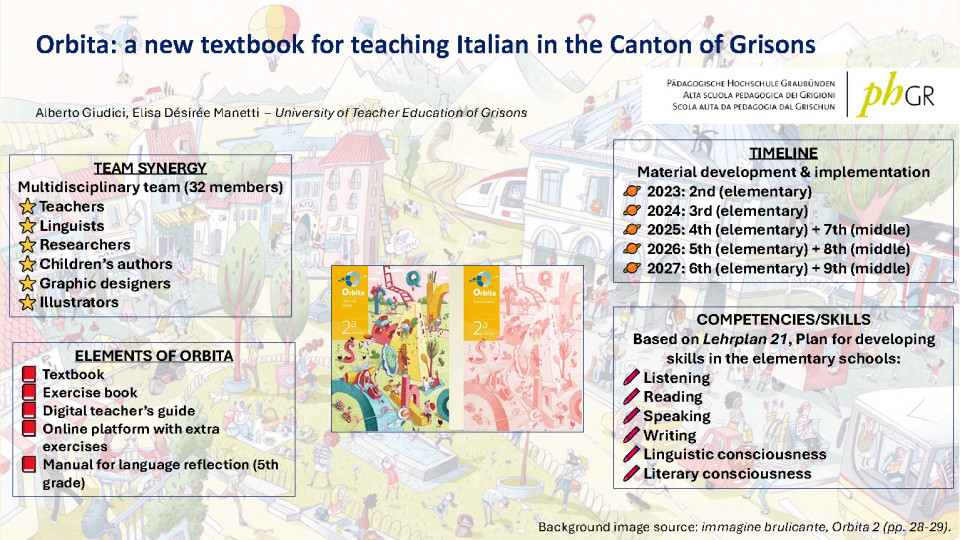Italian Grisons – comprising the regions of Moesa, Bernina, and Maloja – is part of the Canton of Grisons, the only officially trilingual canton in Switzerland. The three regions that make up the Italian-speaking part are not contiguous and can be considered a linguistic archipelago (Moretti & Spiess 2002: 261). This territory, with its very complex history, underwent a process of Italianization starting from the mid-sixteenth century (see Bianconi 2013: 37-39). Elementary schooling was a fundamental element for the diffusion of the language thanks to the innovative project of the archbishop Carlo Borromeo. However, after a period of progress, the school system crystallized, leading to the development of an archaic language model (Bianconi 2001: 111-114). In the nineteenth century, linguistic manuals from the eighteenth century were reprinted, which advocated a bookish model of Italian (Lardi 2017).
Given this historical background, the development of contemporary educational tools is essential to address the evolving needs of students in Italian Grisons. This contribution describes the Orbita textbook, designed as the Italian L1 teaching tool for compulsory schools in Italian Grisons. The student population in Italian Grisons is approximately 1,200 (Casoni et al. 2021: 201; Todisco et al. 2020: 14-18), and the research by Cangemi & Imhof (2019) highlighted the need for a textbook that aligns with the principles of the Lehrplan 21 (the Swiss Curriculum). The Orbita project aims to fulfill this need by providing materials that support the development of all six competency areas indicated by the Curriculum. It promotes mastery of the four language skills (listening, speaking, writing, and reading) and metalinguistic and cultural skills (linguistic awareness and literary awareness).
The Orbita teaching tool comprises a textbook and an exercise book for each class. For secondary school classes, there will be two exercise books, divided by levels. Additionally, a digital guide for teachers is planned, providing detailed planning, competencies, objectives, and possibilities for differentiating various activities. The printed manual for language reflection will be available to students starting from the 5th grade and will be based on the valency method. The materials will be structured into 10 units with five thematic categories (language use, books, authors, text types, reflection on language, and multilingualism).
Our talk will present some case studies from the manual regarding the difficulties encountered in the realisation of this major project.
Bibliography
Bianconi, S. (2001). Lingue di frontiera. Una storia linguistica della Svizzera italiana dal medioevo al 2000. Casagrande.
Bianconi, S. (2013). L’italiano lingua popolare. La comunicazione scritta e parlata dei “senza lettere” nella Svizzera italiana dal Cinquecento al Novecento. Accademia della Crusca – Edizioni Casagrande.
Cangemi, F. & Imhof, A. (2019). Ergebnisbericht Befragung Erstsprachlehrmittel Italienisch in Italienischbünden. Chur.
Casoni, M., Christopher, S., Plata, A., & Moskopf-Janner, M. C. (2021). La posizione dell'italiano in Svizzera. Uno sguardo sul periodo 2012-2020 attraverso alcuni indicatori. Rapporto di ricerca commissionato dal Forum per l'italiano in Svizzera (Quaderno / Divisione della cultura e degli studi universitari, 07).
Lardi, G. (2017). Uno sguardo ai testi didattici nostrali dell’Ottocento e alcuni spunti di storia scolastica grigione. Quaderni grigionitaliani, 86(2), 65–97.
Moretti, B., & Spiess, F. (2002). La Svizzera italiana. M. Cortelazzo et al., I dialetti italiani. Storia, struttura, uso (pp. 261–275). UTET.
Todisco, V., Moskopf-Janner, M. C., Manna, V., Menghini, L., Sala, S., & Zala, E. (2020). Italiano. L’italiano nel sistema educativo svizzero. Regional dossiers series. Mercator European Research Centre on Multilingualism and Language Learning.
